
Step-by-Step Guide: Integrating Excel Sheets Into Microsoft Word

Step-by-Step Guide: Integrating Excel Sheets Into Microsoft Word
Quick Links
- What’s the Difference Between Linking and Embedding?
- How to Link or Embed an Excel Worksheet in Microsoft Word
Sometimes, you want to include the data on an Excel spreadsheet in your Microsoft Word document. There are a couple of ways to do this, depending on whether or not you want to maintain a connection with the source Excel sheet. Let’s take a look.
What’s the Difference Between Linking and Embedding?
You actually have three options for including a spreadsheet in a Word document. The first is by simply copying that data from the spreadsheet, and then pasting it into the target document. For the most part, this only works with really simple data because that data just becomes a basic table or set of columns in Word (depending on the paste option you choose).
While that can be useful sometimes, your other two options—linking and embedding—are much more powerful, and are what we’re going to show you how to do in this article. Both are pretty similar, in that you end up inserting an actual Excel spreadsheet in your target document. It will look like an Excel sheet, and you can use Excel’s tools to manipulate it. The difference comes in how these two options treat their connection to that original Excel spreadsheet:
- If you link an Excel worksheet in a document, the target document and the original Excel sheet maintain a connection. If you update the Excel file, those updates get automatically reflected in the target document.
- If you embed an Excel worksheet in a document, that connection is broken. Updating the original Excel sheet does not automatically update the data in the target document.
There are advantages to both methods, of course. One advantage of linking a document (other than maintaining the connection) is that it keeps your Word document’s file size down, because the data is mostly still stored in the Excel sheet and only displayed in Word. One disadvantage is that the original spreadsheet file needs to stay in the same location. If it doesn’t, you’ll have to link it again. And since it relies on the link to the original spreadsheet, it’s not so useful if you need to distribute the document to people who don’t have access to that location.
Embedding a document, on the other hand, increases the size of your Word document, because all that Excel data is actually embedded into the Word file. There are some distinct advantages to embedding, though. For example, if you’re distributing that document to people who might not have access to the original Excel sheet, or if the document needs to show that Excel sheet at a specific point in time (rather than getting updated), embedding (and breaking the connection to the original sheet) makes more sense.
So, with all that in mind, let’s take a look at how to link and embed an Excel Sheet in Microsoft Word.
How to Link or Embed an Excel Worksheet in Microsoft Word
Linking or embedding an Excel worksheet into a Word is actually pretty straightforward, and the process for doing either is almost identical. Start by opening both the Excel worksheet and the Word document you want to edit at the same time.
In Excel, select the cells you want to link or embed. If you would like to link or embed the entire worksheet, click on the box at the juncture of the rows and columns in the top left-hand corner to select the whole sheet.
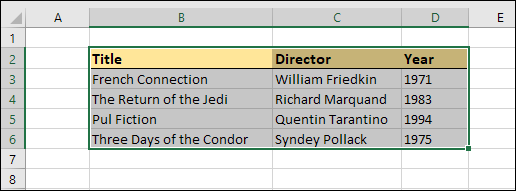
Copy those cells by pressing CTRL+C in Windows or Command+C in macOS. You can also right-click any selected cell, and then choose the “Copy” option on the context menu.

Now, switch to your Word document and click to place the insertion point where you would like the linked or embedded material to go. On Home tab of the Ribbon, click the down arrow beneath the “Paste” button, and then choose the “Paste Special” command from the dropdown menu.
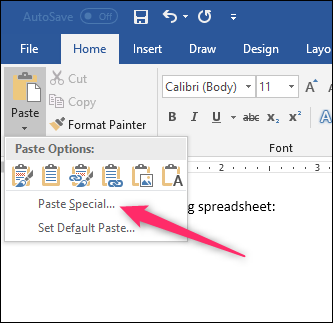
This opens the Paste Special window. And it’s here where you’ll find the only functional different in the processes of linking or embedding a file.
If you want to embed your spreadsheet, choose the “Paste” option over on the left. If you want to link your spreadsheet, choose the “Paste Link” option instead. Seriously, that’s it. This process is otherwise identical.
Whichever option you choose, you’ll next select the “Microsoft Excel Worksheet Object” in the box to the right, and then click the “OK” button.
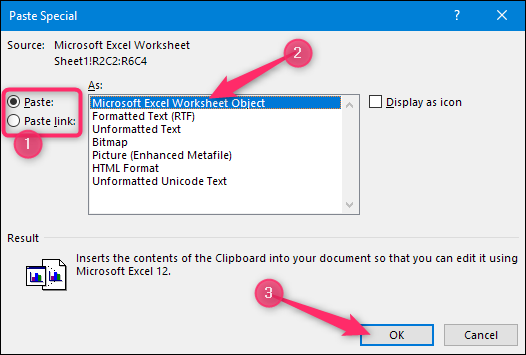
And you’ll see your Excel sheet (or the cells you selected) in your Word document.
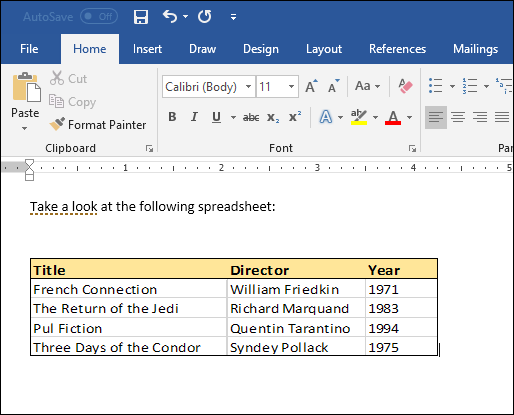
If you linked the Excel data, you can’t edit it directly in Word, but you can double-click anywhere on it to open the original spreadsheet file. And any updates you make to that original spreadsheet are then reflected in your Word document.
If you embedded the Excel data, you can edit it directly in Word. Double-click anywhere in the spreadsheet and you’ll stay in the same Word window, but the Word Ribbon gets replaced by the Excel Ribbon and you can access all the Excel functionality. It’s kind of cool.
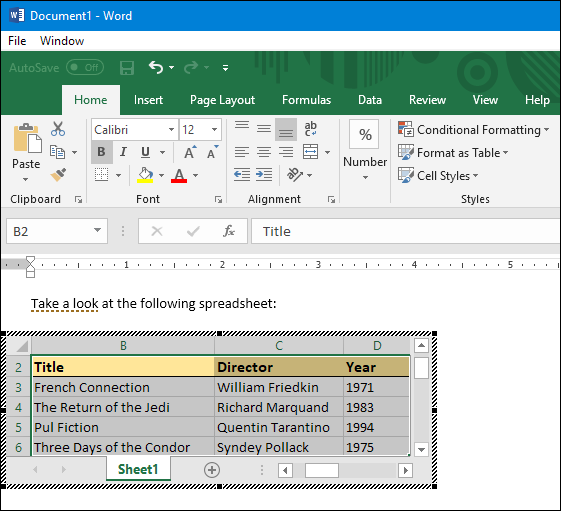
And when you want to stop editing the spreadsheet and go back to your Word controls, just click anywhere outside the spreadsheet.
Note: If you working on a Word document and want to include a spreadsheet that you haven’t created yet, you can. You can actually insert an Excel Spreadsheet right from the Table dropdown menu on the Ribbon.
Related: How To Use Excel-Style Spreadsheets in Microsoft Word
Also read:
- [New] 2024 Approved Peering Into Popularity Twitter’s Top Videos
- [New] Boosting Your Posts Secrets for Viral Instagram Videos
- [New] In 2024, Audio Enhancement Including Tracks in Vimeo Clips
- [Updated] In 2024, Sonic Canvas Painting Sounds on a Mac
- 2024 Approved Skullduggery Scribbler's Den
- 2024 Approved Unveiling the Leading 10 No-Cost YouTube Channels for Stunning Visuals
- In 2024, Mellow Mixdowns Lowlighting with Ease in Garageband
- Resolving 'Entry Point Not Found' Issues on Your Windows System
- Step-by-Step Guide to Sharing Video Content on Pinterest Using Your Smartphone or Computer
- Step-by-Step Guide to Transforming Videos Into MP4 Format Across PC, Mac, and Online Tools
- The Ultimate Guide to Streaming MP4 Content on Your Windows N Operating System
- Top DVD Ripping Software: Securely Convert Your DVDs Into High-Quality Digital Formats
- Top Free Tools for Converting MTS Files to AVI on Windows
- Top-Quality Downloadable Classics: Access Your Favorite Movies From Popular Sites Without Cost
- Transforming Standard Definition Videos Into Crisp, Stunning 4K Resolution
- Troubleshooting Common Problems for Microsoft's Entertainment App on Newest Windows Versions
- Ultimate Fix & Restoration Toolkit for PhotoCorrector Pro 8 (Windows) - Stellar Repair Edition
- Title: Step-by-Step Guide: Integrating Excel Sheets Into Microsoft Word
- Author: David
- Created at : 2025-01-04 19:31:36
- Updated at : 2025-01-06 19:50:31
- Link: https://win11.techidaily.com/step-by-step-guide-integrating-excel-sheets-into-microsoft-word/
- License: This work is licensed under CC BY-NC-SA 4.0.